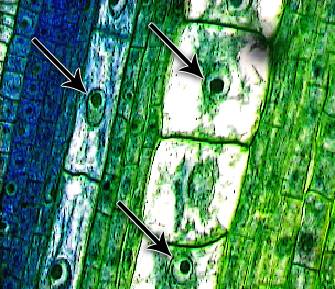The nucleus has two major functions:
- to replicate genetic material (DNA) during cell division.
- to synthesize mRNA by transcription from DNA.

The arrows show nuclei with a prominent nucleus in various cell types from a section of stem.

Most plant cells contain only a single nucleus with one or more nucleoli.
There is a double membrane surrounding the nucleus.

This is a single cell enlarged many times by electron microscopy.
The nucleolus is involved in the synthesis of Ribosomal RNA.
The nucleolus becomes larger and very active prior to cell division in meristematic cells.

The nuclear matrix (also known as the nucleoplasm) contains many ribosomes and chromatin (chromosomes).
The outer membrane of the nucleus contains many pores that allow molecules to move in and out of the nucleus.



